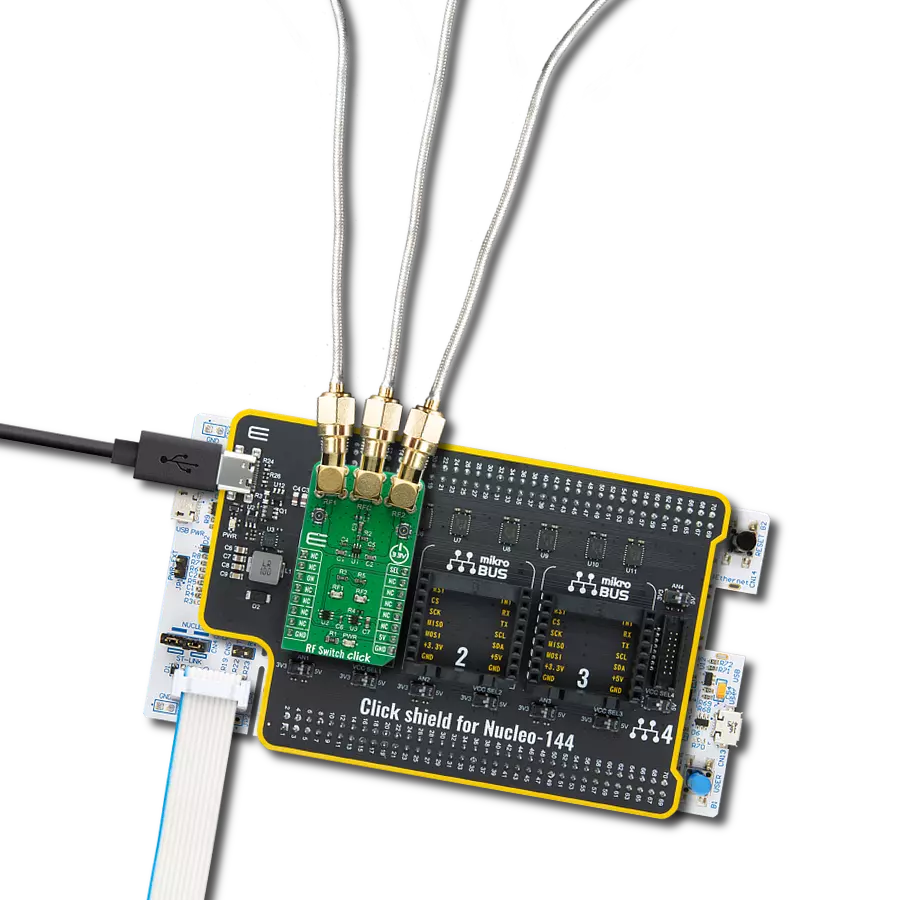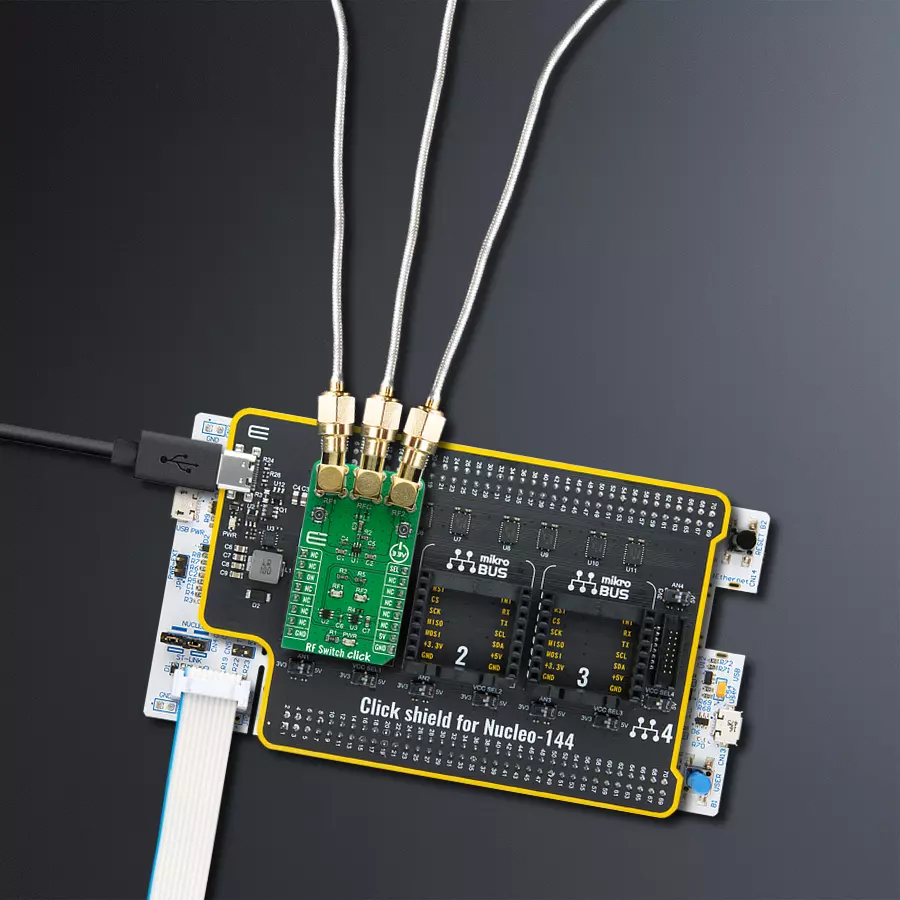Our RF switch solution empowers engineers with a versatile tool for selecting and routing RF signals, enhancing system flexibility and signal quality
A
A
Hardware Overview
How does it work?
RF Switch Click is based on the MASWSS0115, a GaAs PHEMT MMIC single-pole, double-throw (SPDT) switch from Macom in a low cost, lead-free SC-70 (SOT-363) surface mount plastic package. The MASWSS0115 is ideally suited for applications where a very small size and low cost are required. Typical applications are dual-band systems that require switching between small signal components such as filter banks, single-band LNAs, converters, etc. This part can be used for low power, low loss requirements in all systems operating up to 3 GHz, including PCS, GSM, DCS, Bluetooth, and other receive chain applications.
The MASWSS0115 is fabricated using a 0.5 micron gate length GaAs PHEMT process. The process features full passivation for performance and reliability. Featured chip MASWSS0115 provides signal switching of 50MHz to up to 3GHz with an insertion loss of 0.3 dB at 2.4 GHz and power consumption of 5 µA at +2.3V. Ultra High-Speed CMOS inverter labeled as NC7WZ14 is used for driving and controlling an RF switch with the typical switching time of 3,2 ns. Additionally, a load switch TPS22943 can enable or disable the RF switch by electrically detaching the power supply. RF Switch click uses the 5V to supply the
switch driver while 3.3V microcontroller can be used to communicate with the control circuitry. Two LEDs (RF1 and RF2) indicate the current active RF port as a visual representation of a state of the switch. Since RF1 is complementary to RF2, the switching can be achieved with only one GPIO pin. The RFC is an input of the switch with the possibility of redirecting the RF signal to RF1 or RF2 port. Besides switching SEL pin, the pin labeled as ON is used for power control. All of the switch ports are accessible on the connectors located on top of the click board with the addition of miniature coaxial connectors for both RF ports.
Features overview
Development board
Nucleo-144 with STM32F756ZG MCU board offers an accessible and adaptable avenue for users to explore new ideas and construct prototypes. It allows users to tailor their experience by selecting from a range of performance and power consumption features offered by the STM32 microcontroller. With compatible boards, the
internal or external SMPS dramatically decreases power usage in Run mode. Including the ST Zio connector, expanding ARDUINO Uno V3 connectivity, and ST morpho headers facilitate easy expansion of the Nucleo open development platform. The integrated ST-LINK debugger/programmer enhances convenience by
eliminating the need for a separate probe. Moreover, the board is accompanied by comprehensive free software libraries and examples within the STM32Cube MCU Package, further enhancing its utility and value.
Microcontroller Overview
MCU Card / MCU

Architecture
ARM Cortex-M7
MCU Memory (KB)
1024
Silicon Vendor
STMicroelectronics
Pin count
144
RAM (Bytes)
327680
You complete me!
Accessories
Click Shield for Nucleo-144 comes equipped with four mikroBUS™ sockets, with one in the form of a Shuttle connector, allowing all the Click board™ devices to be interfaced with the STM32 Nucleo-144 board with no effort. This way, MIKROE allows its users to add any functionality from our ever-growing range of Click boards™, such as WiFi, GSM, GPS, Bluetooth, ZigBee, environmental sensors, LEDs, speech recognition, motor control, movement sensors, and many more. Featuring an ARM Cortex-M microcontroller, 144 pins, and Arduino™ compatibility, the STM32 Nucleo-144 board offers limitless possibilities for prototyping and creating diverse applications. These boards are controlled and powered conveniently through a USB connection to program and efficiently debug the Nucleo-144 board out of the box, with an additional USB cable connected to the USB mini port on the board. Simplify your project development with the integrated ST-Link debugger and unleash creativity using the extensive I/O options and expansion capabilities. This Click Shield also has several switches that perform functions such as selecting the logic levels of analog signals on mikroBUS™ sockets and selecting logic voltage levels of the mikroBUS™ sockets themselves. Besides, the user is offered the possibility of using any Click board™ with the help of existing bidirectional level-shifting voltage translators, regardless of whether the Click board™ operates at a 3.3V or 5V logic voltage level. Once you connect the STM32 Nucleo-144 board with our Click Shield for Nucleo-144, you can access hundreds of Click boards™, working with 3.3V or 5V logic voltage levels.
Used MCU Pins
mikroBUS™ mapper
Take a closer look
Click board™ Schematic

Step by step
Project assembly
Track your results in real time
Application Output
1. Application Output - In Debug mode, the 'Application Output' window enables real-time data monitoring, offering direct insight into execution results. Ensure proper data display by configuring the environment correctly using the provided tutorial.

2. UART Terminal - Use the UART Terminal to monitor data transmission via a USB to UART converter, allowing direct communication between the Click board™ and your development system. Configure the baud rate and other serial settings according to your project's requirements to ensure proper functionality. For step-by-step setup instructions, refer to the provided tutorial.

3. Plot Output - The Plot feature offers a powerful way to visualize real-time sensor data, enabling trend analysis, debugging, and comparison of multiple data points. To set it up correctly, follow the provided tutorial, which includes a step-by-step example of using the Plot feature to display Click board™ readings. To use the Plot feature in your code, use the function: plot(*insert_graph_name*, variable_name);. This is a general format, and it is up to the user to replace 'insert_graph_name' with the actual graph name and 'variable_name' with the parameter to be displayed.

Software Support
Library Description
This library contains API for RF Switch Click driver.
Key functions:
rfswitch_power_on- RF Switch power on functionrfswitch_switch_channel- RF Switch switch channel functionrfswitch_select_channel- RF Switch select channel function.
Open Source
Code example
The complete application code and a ready-to-use project are available through the NECTO Studio Package Manager for direct installation in the NECTO Studio. The application code can also be found on the MIKROE GitHub account.
/*!
* @file main.c
* @brief RF Switch Click Example.
*
* # Description
* This is an example that demonstrates the use of the RF Switch Click board.
*
* The demo application is composed of two sections :
*
* ## Application Init
* Initialization driver enable's - GPIO, also write log and powers on device.
*
* ## Application Task
* Waiting for valid user input and executes functions based on set of valid commands.
* Results are being sent to the Usart Terminal where you can track their changes.
*
* @author Stefan Ilic
*
*/
#include "board.h"
#include "log.h"
#include "rfswitch.h"
static rfswitch_t rfswitch; /**< RF Switch Click driver object. */
static log_t logger; /**< Logger object. */
void application_init ( void )
{
log_cfg_t log_cfg; /**< Logger config object. */
rfswitch_cfg_t rfswitch_cfg; /**< Click config object. */
/**
* Logger initialization.
* Default baud rate: 115200
* Default log level: LOG_LEVEL_DEBUG
* @note If USB_UART_RX and USB_UART_TX
* are defined as HAL_PIN_NC, you will
* need to define them manually for log to work.
* See @b LOG_MAP_USB_UART macro definition for detailed explanation.
*/
LOG_MAP_USB_UART( log_cfg );
log_init( &logger, &log_cfg );
log_info( &logger, " Application Init " );
// Click initialization.
rfswitch_cfg_setup( &rfswitch_cfg );
RFSWITCH_MAP_MIKROBUS( rfswitch_cfg, MIKROBUS_1 );
if ( DIGITAL_OUT_UNSUPPORTED_PIN == rfswitch_init( &rfswitch, &rfswitch_cfg ) )
{
log_error( &logger, " Communication init." );
for ( ; ; );
}
log_printf( &logger, "------------------------\r\n" );
log_printf( &logger, " Powering device on \r\n" );
rfswitch_power_on( &rfswitch );
Delay_ms ( 100 );
log_printf( &logger, "------------------------\r\n" );
log_printf( &logger, " Select option to \r\n" );
log_printf( &logger, " select channel \r\n" );
log_printf( &logger, "------------------------\r\n" );
log_printf( &logger, " 1. Channel 1 selected \r\n" );
log_printf( &logger, " 2. Channel 2 selected \r\n" );
log_printf( &logger, " 3. Switching channel \r\n" );
log_printf( &logger, "------------------------\r\n" );
}
void application_task ( void )
{
uint8_t tx_buf;
if ( log_read( &logger, &tx_buf, 1 ) ) {
switch ( tx_buf ) {
case '1' : {
rfswitch_select_channel( &rfswitch, RFSWITCH_SELECT_CHANNEL_1 );
log_printf( &logger, " Switching to RF port 1 \r\n" );
log_printf( &logger, "------------------------\r\n" );
break;
}
case '2' : {
rfswitch_select_channel( &rfswitch, RFSWITCH_SELECT_CHANNEL_2 );
log_printf( &logger, " Switching to RF port 2 \r\n" );
log_printf( &logger, "------------------------\r\n" );
break;
}
case '3' : {
rfswitch_switch_channel( &rfswitch );
log_printf( &logger, " Switching RF port \r\n" );
log_printf( &logger, "------------------------\r\n" );
break;
}
default : {
log_printf( &logger, " Select option to \r\n" );
log_printf( &logger, " select channel \r\n" );
log_printf( &logger, "------------------------\r\n" );
log_printf( &logger, " 1. Channel 1 selected \r\n" );
log_printf( &logger, " 2. Channel 2 selected \r\n" );
log_printf( &logger, " 3. Switching channel \r\n" );
log_printf( &logger, "------------------------\r\n" );
}
}
}
}
int main ( void )
{
/* Do not remove this line or clock might not be set correctly. */
#ifdef PREINIT_SUPPORTED
preinit();
#endif
application_init( );
for ( ; ; )
{
application_task( );
}
return 0;
}
// ------------------------------------------------------------------------ END



































